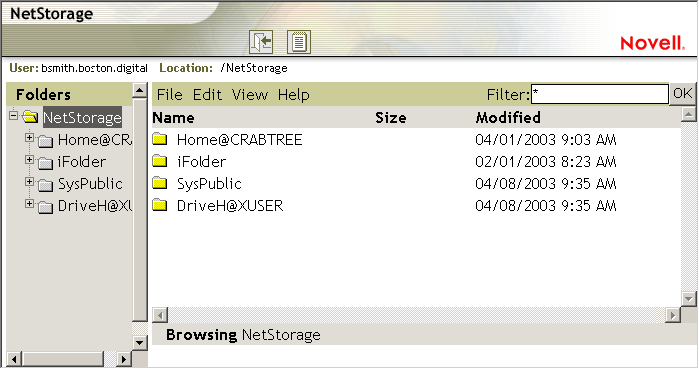1.2 What Users See When They Access NetStorage
The NetStorage Web page displays the network files and folders currently accessible for each user. NetStorage reads the user's login script to determine drive mappings, reads eDirectory User object properties to determine the path to the user's home directory, then displays a list of files and folders based on the mapped drives and home directories. If Storage Location objects have been created and the user has rights to view these objects, the directories associated with these objects are also displayed.
Figure 1-2 NetStorage Folder View

NetStorage reads the container, profile, and user login scripts only from the primary eDirectory server specified during the installation, and displays the user's drive mappings based only on those login scripts. However, because login scripts were designed to be processed by the Novell Client on the user’s workstation, NetStorage processes only a subset of the login script functions.
HINT:If you specified alternate IP addresses or DNS names of servers in other eDirectory trees during the NetStorage installation, NetStorage reads the User object properties in the other eDirectory trees and also displays those home directories. This is useful if a user normally logs in to more than one eDirectory tree and you want that user to have access to additional home directories in different eDirectory trees through NetStorage. The User object name must be the same for each eDirectory tree.
NetStorage processes login scripts in order to find MAP statements. Each MAP statement defines a NetWare file system storage resource that the user can access through NetStorage. IF, ELSE, END, INCLUDE, and EXIT commands are also recognized by NetStorage. All other login script statements are treated as comments and ignored. Finally, login script variables are also recognized. Variables are preceeded by a percent sign (%).
Users might have specific eDirectory rights to certain files and folders on your network but cannot access those files and folders through NetStorage unless login script drive mappings exist to those folders or the files and folders are in the user's home directory. If you want to provide users with NetStorage access to a specific folder, you might need to add a drive mapping command to that folder in a login script (container, profile, or user).